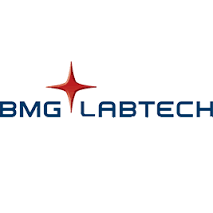Introduction
State of the art biotechnology relies on many different analytical techniques in combination with high throughput screening (HTS) methodology. The detection and quantitation of minute amounts of DNA is routinely done in a high percentage of these applications. One of the most common methods for nucleic acid detection is the measurement of solution absorbance at 260 nm (A260). Although a relatively simple method, A260 suffers from low sensitivity and interference from nucleotides and single-stranded nucleic acids. Furthermore, compounds commonly used in the preparation of nucleic acids absorb at 260 nm leading to abnormally high quantitation levels.1 New fl uorescent staining techniques can be much more sensitive and specifi c for double stranded DNA (dsDNA) than absorbance methods. The PicoGreen® dsDNA quantitation reagent from Molecular Probes is a highly sensitive fl uorescence assay for dsDNA detection. PicoGreen® is widely used in industry and is quickly becoming a standard dsDNA quantitation method due to the high degree of sensitivity, linearity, and dynamic range achievable. This application note investigates a method for using the PicoGreen® assay on the BMG LABTECH POLARstar OPTIMA microplate reader.
Materials
All materials were obtained through normal distribution channels from the manufacturer stated. PicoGreen® dsDNA quantitation kit, Cat.# P-7589, Eugene, Oregon Distilled water, Winter Mountain Co., Marion North Carolina POLARstar OPTIMA, PN 413-201, BMG LABTECH, Offenburg, Germany 3 mm fl uorescence optic, BMG LABTECH, Offenburg, Germany Corning® Microplates, black 96-well, Cat.# 3915, Corning, NY In addition, consumables such as pipette tips and microcentrifuge tubes were used as needed from various manufacturers.
Experimental
A complete description of this preparation for microplate assays has been given previously.2 Reagents: A: PicoGreen® dsDNA quantitation reagent, 1 mL solution in DMSO B: 20X TE, 25 mL of 200 mM Tris-HCl, 20 mM EDTA, pH 7.5 C: Lambda DNA standard, 1 mL of 100 µg/mL DNA standard in TE buffer Stock working TE buffer is made by diluting reagent B 1:20 in distilled water free of nucleic acids. The working PicoGreen® reagent is made by dilution of reagent A 1:200 in TE buffer. A stock DNA solution at 100 ng/mL was made by dilution of reagent C 1:1000 in TE buffer. A serial dilution of the stock DNA solution was performed yielding seven concentrations ranging from 0.78 ng/mL to 50 ng/mL. 100 µL if each preparation was placed in duplicate into a microplate for measurement. 100 µL of the working PicoGreen® reagent was added to each measurement well yielding fi nal assay concentrations ranging from 0.39 ng/mL to 25 ng/mL. The blank solution was prepared identically except without the stock DNA solution. The prepared 96-well plate was inserted into the instrument, allowed to incubate for fi ve minutes at room temperature, and then read in fl uorescence mode using the following parameters: Excitation fi lter: 485P Emission fi lter: 520P Gain: 1300 Optics: 3 mm liquid light guides Number of cycles: 1 Number of fl ashes: 10 Shake time: 60 s before reading cycle The data from the measurement was evaluated using the BMG LABTECH POLARstar evaluation package. The average value of the blank measurement was subtracted from the duplicate measurements made at each concentration and the results plotted. A linear regression was performed on the standard curve to provide the limit of detection (LOD).
Results and Discussion
The dsDNA assay using the PicoGreen® reagent was linear over the range tested, 0.39 ng/mL to 25 ng/mL dsDNA (fi gure 1). A linear regression was performed on the data which yielded an R2 value of 0.999 and blanks were repeatedly measured (n=20) to determine the standard deviation of a well measurement. Using these parameters the LOD was calculated to be 104 pg/mL dsDNA or 21 pg dsDNA in 200 µL. Contributing in no small part to these values is the small standard deviation of measurements achieved through the use of a fl ashlamp excitation source.
The small degree of variance between each flash that makes up a single measurement on a well is approximately 3%. This fact combined with the relatively large number of flashes (n = 10 – 20 in most cases) used for each measurement creates a high degree of reproducibility when repetitive measurements are made.
Through this independent analysis it would appear that the claims made by Molecular Probes regarding a detection limit of 50 pg in 200 µL using a microplate reader is valid under optimized conditions. Although individual sensitivity will vary depending upon contaminants and other environmental assay parameters, the PicoGreen® reagent can be readily used in the picogram quantitation range. Very little is known about how the PicoGreen® reagent binds to dsDNA, however, the binding does exhibit a high degree of dependence upon salt concentration which suggests it binds through an ionic interaction. This interaction can be affected by other assay parameters but these influences are beyond the scope of this study. Reference 2 has a complete list of known effectors on assay performance. Compared with conventional dsDNA quantitation techniques the PicoGreen® assay is a viable and inexpensive alternative assay that can be scaled and adapted to high throughput systems.
References
1. Maniatis T, Sambrook J, Fritsch EF, „Molecular Cloning: A Laboratory Manual”, Second Edition, Cold Spring Harbor Laboratory Press, 1989. 2. „PicoGreen® dsDNA Quantitation Reagent and Kits”, Product Information, Molecu

